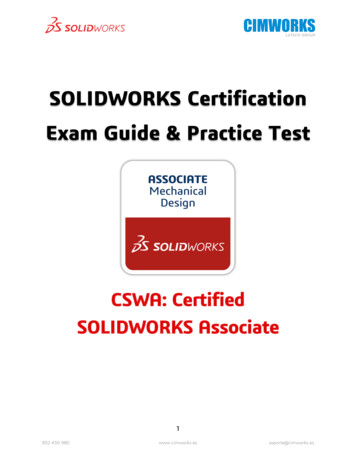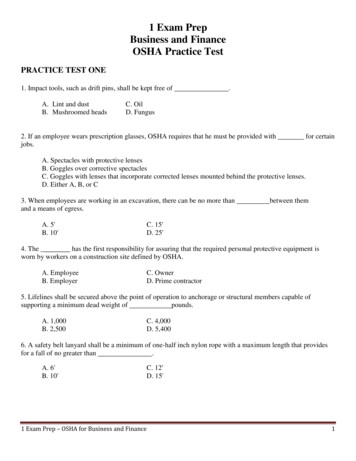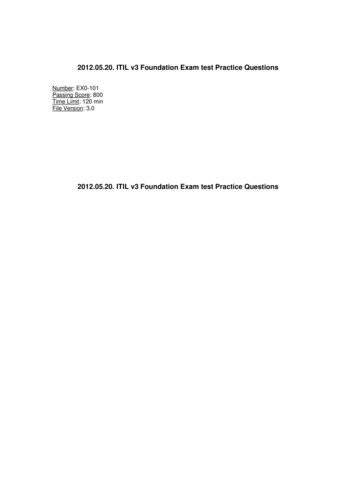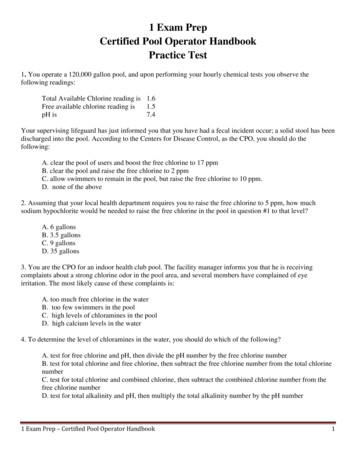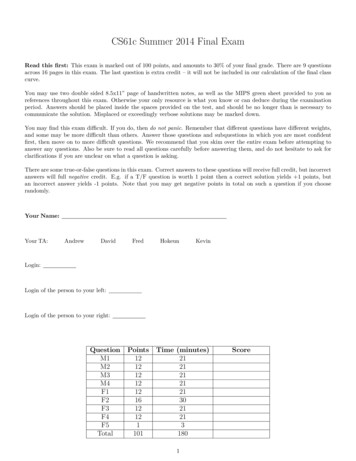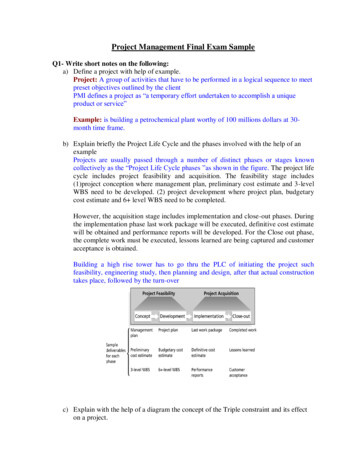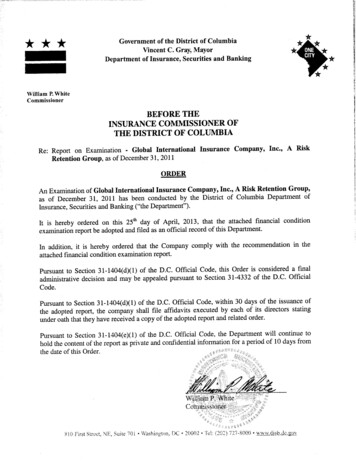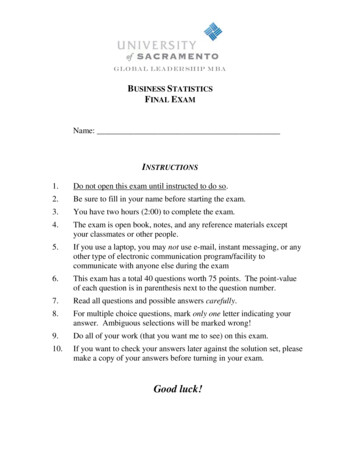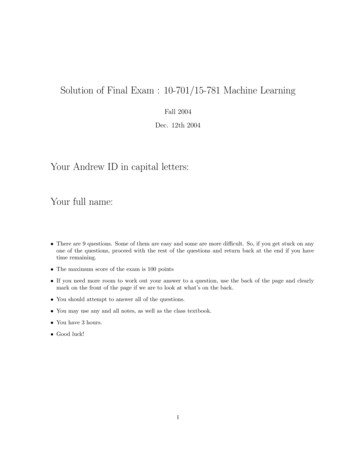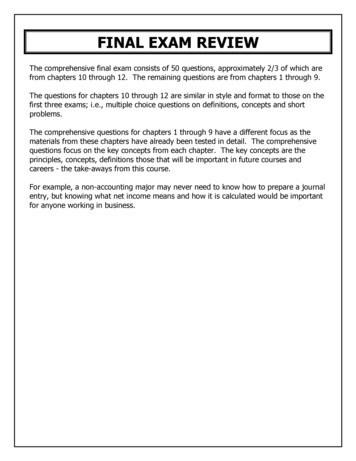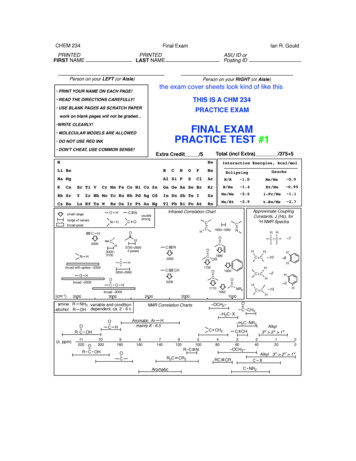
Transcription
CHEM 234Final ExamPRINTEDFIRST NAMEIan R. GouldPRINTEDLAST NAMEASU ID orPosting IDPerson on your LEFT (or Aisle)Person on your RIGHT (or Aisle)the exam cover sheets look kind of like this PRINT YOUR NAME ON EACH PAGE!THIS IS A CHM 234 READ THE DIRECTIONS CAREFULLY! USE BLANK PAGES AS SCRATCH PAPERPRACTICE EXAMwork on blank pages will not be graded. WRITE CLEARLY!FINAL EXAMPRACTICE TEST #1 MOLECULAR MODELS ARE ALLOWED DO NOT USE RED INK DON'T CHEAT, USE COMMON SENSE!Total (incl Extra) /375 5Extra Credit /5HHeBNOFNeNa MgAl Si PSClArH/H 1.0Me/Me 0.9Ga Ge As Se BrKrH/Me 1.4Et/Me 0.95In Sn Sb Te IXeMe/Me 2.6i-Pr/Me 1.1Tl Pb Bi Po AtRnMe/Et 2.9t-Bu/Me 2.7KCaSc Ti VCr Mn Fe Co Ni Cu ZnRb SrYZr Nb Mo Tc Ru Rh Pd Ag CdCs BaLu Hf Ta Wsmall rangerange of valuesbroad peakRe Os Ir Pt Au HgO HC NN HC OCInteraction Energies, kcal/molLi BeCHOC HHCNO2850–29603500O10200Aromatic Ar Hmainly 8 - 6.5C CH3R C OH–H2C NR2C CH29180OC8160HO–OCH2–NMR Correlation Charts714061205100R2CAromaticCR2C CH480360RCCRAlkyl3Y 2Y 1Y240–OCH2–R C NH 15C C1500–H2C X11220 O 2HNR216502000HHC1710amine R NH2 variable and conditionalcohol R OH dependent, ca. 2 - 6 δ(δ, ppm) 8 2C CO22002500OC HH 10H1600C3000OR C OHHC COR1735CHbroad 3000(cm-1) 7HCOC O Hbroad 3300H1680CHbroad with spikes 3300O HH HC CC2200CNO2720–28202 peaks3000–3100N HC1600–1660HC3300Approximate CouplingConstants, J (Hz), for1H NMR SpectraInfrared Correlation ChartusuallystrongCGaucheEclipsing12000Alkyl 3Y 2Y 1YC XC NR2
CHM 234, FINAL EXAM PRACTICE TEST #1NAME- 2-Question Provide IUPAC names for the following structures, do not forget to use E/Z and R/Sas appropriate.a)CO2Hb)OCH2CH2CH3Question 2) Rank the following in order of Lewis base strength, and give a BRIEFexplanationHHHABB HHHAlHCHH––– ––– –––Question 3) Indficate which of the following two structures A or B would react fastest with adiene in a Diels-Alder reaction. Give an explanation that includes the following terms:"energy of the HOMO", "energy of the LUMO", and also "withdrawing substituent" and"donating substituent", you should also identify and withdrawing and donating substituentsOAOBO
CHM 234, FINAL EXAM PRACTICE TEST #1NAME-3 -Question 4) Rank the following in order of increasing Bronsted acidity. For each, ADD THEMISSING MOST ACIDIC HYDROGEN ATOM to the provided structure and draw the conjugatebase anion, include any important resonance contributors and give a brief explnanation for yourchoicesOOOOOOACBOO-H –––leastacidic ––– ––– –––mostacidicOCH3D-H O-H -H
-4-CHM 234, FINAL EXAM PRACTICE TEST #1NAMEQuestion 5 (Give a curved arrow pushing mechanism for the following reactions AS APROPRIATE, SHOW WHERE ALL PROTONS COMES FROM AND GO TO (no H /-H ) DRAW ALL RESONANCE CONTRIBUTORS for the intermediates as appropriate At each INTERMOLECULAR step, INDICATE THE Lewis acid and base (LA or LB) andwhether they are also Bronsted acids and bases (BA or BB) as appropriateOa)HCH2OOb)CH2CH3H2O1. LiAlH4Cl2. H3O CCH3OOOOOc)COHH2O / NaOHOHH HO
CHM 234, FINAL EXAM PRACTICE TEST #1-5-NAMEQuestion 6 Provide the missing major organic products, or reagents/conditions, or organicreactants, as appropriate. Do not forget to include stereochemistry as appropriateunless specified otherwise.1. PBr3OHa)2. Mg.THF3. CH3CHO4. H3O NCb)CNheatOPhOHc)Od)1. LiAlH42. H3O OOCH3NH2e)H (cat.)PhOClf)OOO
-6-CHM 234, FINAL EXAM PRACTICE TEST #1NAMEQuestion 6, contd.OH2 / Ptg)OOHh)HON2H4/KOHi)heatBrOBr2H (cat.)j)CH3CO/HCl/AlCl3k)H3Cl)N1. Excess MeI2. Ag2O/heatm)NH2N2 –Cl
CHM 234, FINAL EXAM PRACTICE TEST #1-7-NAMEQuestion 7) Protonation of the alcohol below results in loss of water as a leaving group togenerate a cation that undergoes an electrocyclic ring closing reaction OHOH H 2- H2OΔa) give the curved arrow-pushing that accounts for electrocyclic reactionb) draw the electrocyclic product, paying special attention to relative stereochemistry of anysubstituentsc) in the product(s), indicate the locations of any chiral (asymmetric) carbons* atoms with the*symbol, and state whether the product(s) are racemic, a meso compound or achirald) ON TOP OF THE CATION STRUCTURE, give a drawing of the HOMOe) state the number of vertical nodes and clearly indicate their positionsf) state whether the allowed reaction proceeds via a conrotatory or a disrotatory ring closingQuestion 8) Provide the missign structures in the following malonic ester synthesis of acarboxylic acidmalonic esterEtOOEtOCO2HONaOEtH3O , heatCH3CH2BrNaOEt
CHM 234, FINAL EXAM PRACTICE TEST #1NAME-8-Question 9) Show how you would make the target componds on the right from the starting compounds onthe left. Show reagents and conditions where appropriate, and the structures of important intermediatecompounds. Do not show any (arrow pushing) mechanisms. If necessary, you must indicate steps thatrequire separation of isomersCOa)Clb)O2NNH2
CHM 234, FINAL EXAM PRACTICE TEST #1-9-NAMEQuestion 10) Show how you would make the target componds on the right from thestarting compounds on the left. Show reagents and conditions where appropriate,and the structures of important intermediate compounds. Do not show any (arrowpushing) mechanisms.THESE SYNTHESIS PROBLEMS USE ONLY REACTIONS FROM THE"MINIMAL SET OF REACTIONS" PROVIDED ON THE CLASS WEB PAGE!a)b)OHOHBrQuestion 11) Give a curved arrow pushing mechanism for the following reactions SHOW WHERE ALL PROTONS COMES FROM AND GO TO (no H /-H ) (assuem that H-Cl iscompletely dissociated in methanol DRAW ALL RESONANCE CONTRIBUTORS for the intermediates as appropriate At each INTERMOLECULAR step, INDICATE THE Lewis acid and base (LA or LB) and whetherthey are also Bronsted acids and bases (BA or BB) as appropriate Add hydrogen atoms and non-bonding electrons where appropriateOHMeOH (solvent)HCl (cat.)O
CHM 234, FINAL EXAM PRACTICE TEST #1NAME- 10 -Question 12) Disconnect the indicated bond according to the method of retrosynthetic analysis,generate the synthons and convert these into "real reagents", or "synthetic equivalents".OOsynthons Hsyntheticequivalents Question 13) For the Bronsted acid/base reaction below, label the acids/bases and which arestronger and give a brief explanation, give the curved arrow-pushing in both directions, draw areaction energy diagram and include a drawing of the transition state, indicate which reaction isfaster (left to right or vica versa) and on which side the equilibrium liesHH3CCN NHHCH3CH3CCH3CNH CH3NCCH3
CHM 234, FINAL EXAM PRACTICE TEST #1- 11 -NAMEQuestion 13) Synthesize the (target) molecule on the right from the starting molecule on theleft. this can not be done in one reaction. Give reagents and conditions and the intermediatemolecules at each step. Do not show any mechanisms or transient intermediates.NQuestion 14) Provide the major organic product of the following reaction and classify it as anAldol or a Claisen reactionOPhOTsOH (cat.)/heatPhQuestion 15) Provide the reactants/reagents/conditions to for the provided product and statewhether the reaction is an Aldol condensation or a Claisen reactionOOPhQuestion 16) Explain why electron donating substituents on a benzene ring increasereactivity in electrophilic aromatioc substitution, whereas electron donating groups on a C Ogewnerally decrease reactivity in nucleophilic addition, e.g. reaction with Grignards.
CHM 234, FINAL EXAM PRACTICE TEST #2- 2-NAMESTART OF PRACTICE TEST #2Question 1) Provide IUPAC names for the following structures, do not forget to use E/Z andR/S as appropriate.Oa)Hb)CO2HQuestion 2) Provide a curved arrow pushing mechanism for the following reactions (indicate LB/LAand BB/BA as appropriate). For any resonance stabilized intermediates, include all relevantresonance contributors, INDICATE WHICH IS THE MAJOR CONTRIBUTOR and explain WHY, anddraw an "actual" structure using the "delta" notation to indicate partial charges. Indicate whichwould be the major product under conditions of kinetic control and which under thermodynamiccontrol, give a BRIEF explanation for your choice that metions temperature.Br2BrBr ABrignorestereochemistryBBr
CHM 234, FINAL EXAM PRACTICE TEST #2NAME-3 -Question 3) Rank in order of increasing basicity and give a brief explanationHHNANBC––– N––– –––HQuestion 4) Rank the following hydrogens Ha, Hb and Hc in order of increasing Bronsted acidity, drawstructures of the relevant conjugate base anions to support your reasoning andfgive a brief explanationOHaO––– ––– –––HbOOHcQuestion 5) In what way is the Lewis acid/base description of reactions idifferent from thenucleophile/electrophile description?
-4-CHM 234, FINAL EXAM PRACTICE TEST #2NAMEQuestion 6) Indicate which of the following two reactions, A or B would be faster. GIVE ANEXPLANATION THAT INCLUDES A DISCUSSION OF THE EXOTHERMICITY ORENDOTHERMICITIES OF THE REACTIONS (only 1 point for the correct answer, 9 pts for theexplanation, include the term "energy of the electrons" in your explanation)MeOHBrA Br BrheatBrBMeOHheatQuestion 7)a) Give the structures of the best anion and alkyl halide pair that can be used to form theprovided ether (this is a Williamson ether synthesis).O b) Give the structures of the amine and the carbonyl compound that can be used to make theprovided amine in a reductive amination, you should also add the reagents/conditions to thereaction arrow (you can specify reagents for either an indirect or a direct reductive amination)HN c) Give the structures of carbonyl compounds which could be used to prepare thefollowing using an Aldol or Claisen type reaction and also provide example reagents andconditionsOO PhOCH3Ph
-5-CHM 234, FINAL EXAM PRACTICE TEST #2NAMEQuestion 8) Provide the missing major organic products, or reagents/conditions, ororganic reactants, as appropriate. Do not forget to include stereochemistry asappropriate unless specified otherwise.O1. SOCl2OHa)O2.HOHOb)NaOEtheatO1. –OH, H2O, heatNHc)2. H3O (neutralize)Br1. Mg.THFd)2. D2OONaBH4e)EtOHOHf)HONa2Cr2O7/H2SO4/H2O
CHM 234, FINAL EXAM PRACTICE TEST #2-6-NAMEQuestion 8, contd.heatg)(electrocyclic closure)NH2CF3h)heatOCli)1. Excess EtMgBr2. H3O OOk)l)NClj)HOOOEtN2 –Cl1. CuCN2. LiAlH43. H3O
CHM 234, FINAL EXAM PRACTICE TEST #2-7-NAMEQuestion 9) Show how you would make the target componds on the right from the startingcompounds on the left. Show reagents and conditions where appropriate, and the structures ofimportant intermediate compounds. Do not show any (arrow pushing) mechanisms. If necessary,you must indicate steps that require separation of isomersHONOHCO2HO
CHM 234, FINAL EXAM PRACTICE TEST #2NAME-8-Question 10) Draw the complete arrow pushing mechanism for the following reaction. Indicate the Lewisacid/base at each step, and if they are also Brønsted acids bases. Add non-bonding electrons asnecessary. Draw the ALL important resonance structure of the intermediatesDCl/D2O deuterated HCl in heavy water, D2O, acts just like any acid in water, but shows you whichprotons come from the aqueous acid mediumONDCl/D2OD NDDQuestion 11) Give the product of the following Bronsted acid/base reaction, give the curvedarrow pushing and give a BRIEF explanation for your choice of reaction productHNNH-Br
CHM 234, FINAL EXAM PRACTICE TEST #2-9-NAMEQuestion 12) Show how you would make the target componds on the right from thestarting compounds on the left. Show reagents and conditions where appropriate,and the structures of important intermediate compounds. Do not show any (arrowpushing) mechanisms.THESE SYNTHESIS PROBLEMS USE ONLY REACTIONS FROM THE"MINIMAL SET OF REACTIONS" PROVIDED ON THE CLASS WEB PAGE!CO2Ha)b)PhQuestion 13) Draw the complete arrow pushing mechanism for deamination of cytosine togive uracil. Indicate the Lewis acid/base at each step, and if they are also Brønsted acidsbases. Add non-bonding electrons as necessary. Draw the ALL important resonancestructure of the intermediates. This is an acid hydrolysis mechanism that is veryt similar tomany we covered in classNHNcytosineNHOHOH3O H2ONNHHuracilO
CHM 234, FINAL EXAM PRACTICE TEST #2- 10 -NAMEQuestion 14) Draw the complete arrow pushing mechanism for the following reaction.Even though we have not seen this one it just uses principles that we have seen. (hint:start by doing two consecutive SN2 reactions at the benzylic carbon)BrOBrExcess NaOHHQuestion 15) For the following cation, draw all reasonable additional resonance contributorsincluding appropriate curved arrow pushing, and on TOP of the provided structure, draw theHOMO using "p A.O." notation we used in class and CLEARLY INDICATE ANY VERTICALNODES, AND state the number of p A.O.s involved, the TOTAL number of pi-molecular orbitalsthat are possible and the number of electrons in the pi-systemQuestion 16) Assign the following structures as aromatic, non-aromatic or anti-aromatic andf givethe number of electrons associated with the conjugated systems, assume that the structures areas planar as possibleNMeNN Me
CHM 234, FINAL EXAM PRACTICE TEST #2NAME- 11 -Question 17) Synthesize the (target) molecule on the right from the starting molecule on theleft. this can not be done in one reaction. Give reagents and conditions and the intermediatemolecules at each step. Do not show any mechanisms or transient intermediates.ONHCH3HHOOQuestion 18) Alkenes react with ozone, O3, to form an ozonide, an example reaction with trans-2-buteneis shown below.ozone OO OΔtrans-2-butenea) give the curved arrow-pushing that accounts for formation of the ozonideb) draw the ozonide, paying special attention to relative stereochemistry of any substituentsc) indicate the locations of any chiral (asymmetric) carbons atoms with the * symbol, and state whetherthe ozonide is racemic, a meso compound or achirald) give drawings of the HOMO and LUMO, ON TOP OF OZONE and trans-2-BUTENE, respectivelye) state the number of vertical nodes for each MO and cleariy indicate their positionsf) state whether the allowe
CHM 234, FINAL EXAM PRACTICE TEST #2- 2 -NAME Question 1) Provide IUPAC names for the following structures, do not forget to use E/Z and R/S as appropriate. START OF PRACTICE TEST #2 a) O H b) CO 2H Question 2) Provide a curved arrow pushing mechanism for the following reactions (indicate LB/LA and BB/BA as appropriate). For any resonance .
